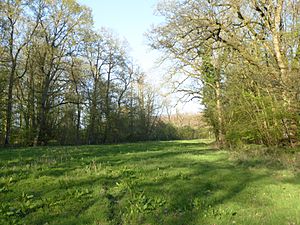Whittlewood Forest facts for kids
| Site of Special Scientific Interest | |

Say's Copse
|
|
| Area of Search | Northamptonshire |
|---|---|
| Interest | Biological |
| Area | 400.1 hectares |
| Notification | 1985 |
| Location map | Magic Map |
Whittlewood Forest is an old forest in Northamptonshire, England. It's located east of Silverstone. This forest used to be a special hunting ground for kings and queens a long time ago. Today, Forestry England takes care of it.
Inside the forest, you can find very old parts of woodland. There are also ancient ditch boundaries around some of the individual woods. People have studied the history of this area a lot. About 400 hectares (which is like 1,000 football fields) of the forest are protected. These protected areas are called a Site of Special Scientific Interest (SSSI) because they are important for nature.
Contents
Where is Whittlewood Forest?
The main part of Whittlewood Forest is found between several villages. These villages include Silverstone, Syresham, Abthorpe, Wicken, and Potterspury. The forest also stretches south towards the border between Northamptonshire and Buckinghamshire.
Many woods are connected, forming the biggest part of the forest. Hazelborough Wood is a good example of this. Other woods, like Bucknell Wood, are separate. There are also scattered woods east of Whittlebury village, reaching towards Potterspury. You can even find small parts of the forest in nearby villages and across the county border into Buckinghamshire and Milton Keynes. Whistley Wood, west of Syresham, is another example of a smaller, separate part.
Who Manages the Forest?
The Forestry Commission looks after Whittlewood Forest. They also manage other nearby woods, such as Salcey Forest and Yardley Chase. Some parts of the forest are specially protected as a SSSI. These protected areas are often small groups of trees called copses. They are what's left of the old Royal Forest.
What Animals and Plants Live Here?
In mid-spring, many parts of the forest are covered in beautiful bluebells. You can also spot other plants that show the woodland is very old. These include Yellow rattle and Lesser celandine.
The forest has tall beech and oak trees. Between them, you'll find hazel trees that used to be cut back regularly (this is called coppicing). There are also areas with conifer trees, which are like pine trees. The conifer areas are slowly being changed back to native hardwood trees. This means more oak and beech trees will be planted. Coppicing, which was a way to manage the woods, is not done much anymore. You can still see the old stumps where trees were cut.
Many different types of deer live in the forest. These include red deer, roe deer, and even small Muntjac deer. Foxes and badgers are also common animals you might find.
For birds, you can see buzzards flying overhead. Sometimes, people even spot Red kites. These large birds might be coming from the growing population in the Chilterns.
The SSSI parts of the forest have very old, natural woodlands. Many trees, especially pedunculate oaks, are very mature. There are also many ash trees and some silver birches and aspens. The old oak trees are home to rare beetles. You can also find rare lichens growing here.
Can You Visit Whittlewood Forest?
Yes, some areas of Whittlewood Forest are open for everyone to visit. There are also footpaths that go through other parts, like Say's Copse. However, some areas are private land, so you cannot enter them.


